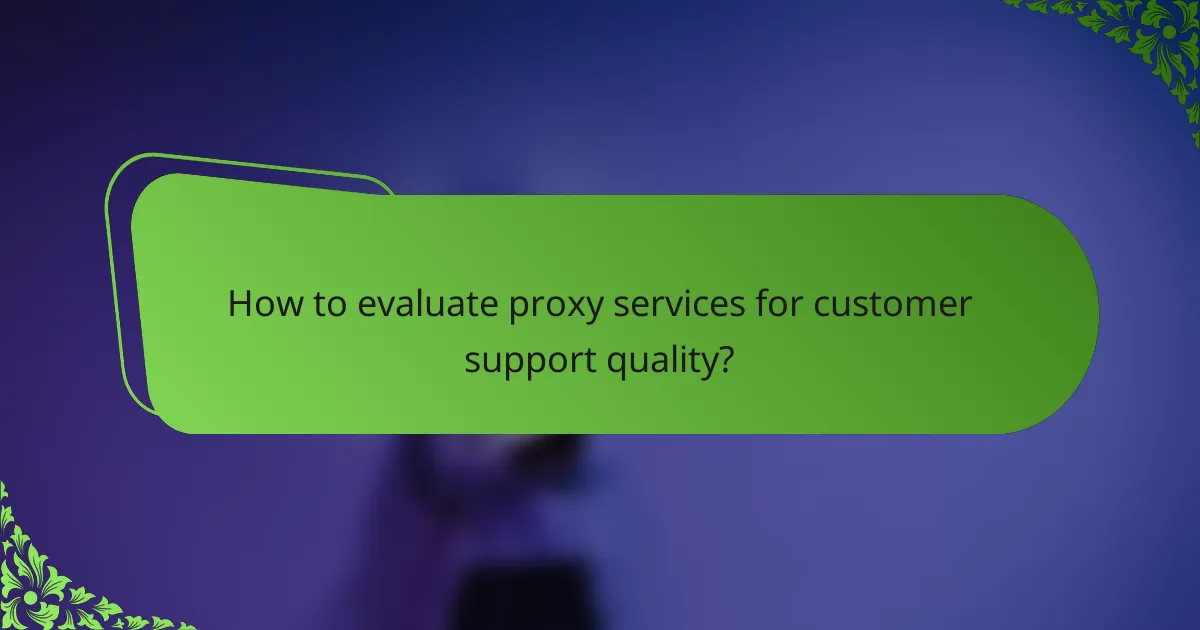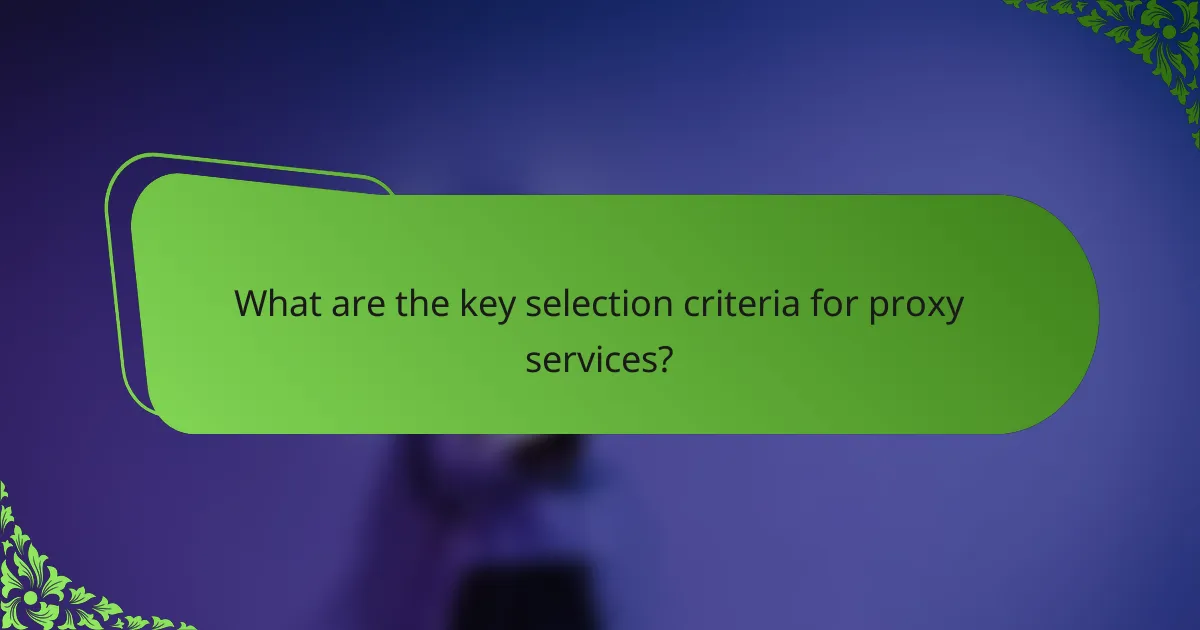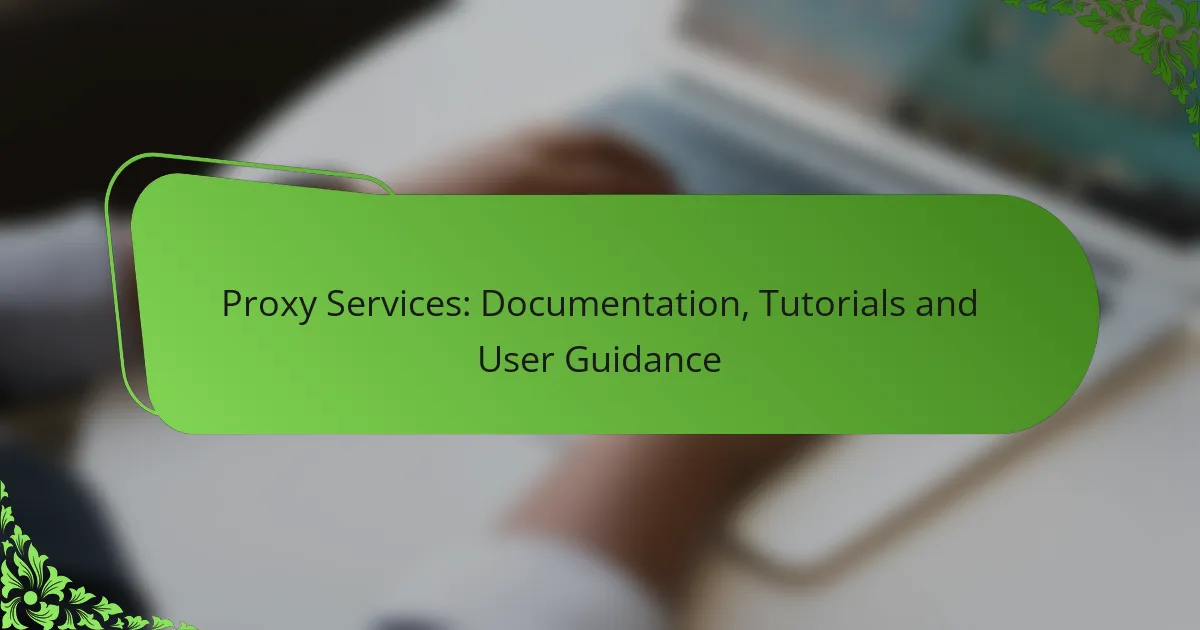When choosing a proxy service, the quality of customer support is a crucial factor that can significantly impact your experience. Key aspects to evaluate include responsiveness, customer satisfaction ratings, and the variety of support channels available. Additionally, considering scalability, pricing models, and geographic coverage will help ensure the service aligns with your specific requirements.

How to evaluate proxy services for customer support quality?
To evaluate proxy services for customer support quality, focus on their responsiveness, customer satisfaction, and available support channels. A reliable proxy provider should demonstrate quick response times, high satisfaction ratings, and multiple ways for customers to get assistance.
Response time metrics
Response time metrics are crucial for assessing how quickly a proxy service can address customer inquiries. Look for services that typically respond within a few minutes to a couple of hours, as this indicates a commitment to customer support. Some providers may publish average response times on their websites, which can serve as a useful benchmark.
Consider testing response times by reaching out with a simple question before committing to a service. This firsthand experience can provide insight into their actual performance.
Customer satisfaction ratings
Customer satisfaction ratings reflect the overall experience users have with a proxy service. Check review platforms and forums for ratings, which often range from 1 to 5 stars. A service with an average rating above 4 stars generally indicates a positive customer experience.
Pay attention to the number of reviews as well; a service with many reviews and high ratings is often more reliable than one with few reviews. Look for patterns in feedback to identify common strengths or weaknesses.
Support channel availability
Support channel availability refers to the different ways customers can reach out for help. Ideal proxy services offer multiple channels, such as live chat, email, and phone support. This variety allows users to choose the most convenient method for their needs.
Check the hours of operation for each support channel. Services that provide 24/7 support are preferable, especially for businesses that may require assistance outside standard working hours.
Service level agreements
Service level agreements (SLAs) outline the expected level of service, including response times and support availability. Review the SLA of a proxy service to understand their commitments regarding customer support. A well-defined SLA can provide peace of mind and set clear expectations.
Look for SLAs that guarantee specific response times and resolutions for support requests. This transparency can help you assess the reliability of the service before making a decision.
Real user testimonials
Real user testimonials offer valuable insights into the actual experiences of customers with a proxy service. Seek out testimonials on the provider’s website, as well as independent review sites, to get a balanced view. Positive testimonials often highlight effective support and quick resolutions to issues.
Be cautious of overly positive testimonials that may seem scripted. Look for detailed accounts that mention specific interactions with customer support, as these can provide a clearer picture of what to expect.

What are the key selection criteria for proxy services?
When selecting proxy services, consider factors such as scalability options, pricing models, integration capabilities, and geographic coverage. These criteria will help ensure that the service meets your specific needs and can adapt to changing requirements.
Scalability options
Scalability is crucial for proxy services, especially if your needs may grow over time. Look for providers that offer flexible plans, allowing you to increase or decrease your usage without significant penalties.
Consider whether the service can handle sudden spikes in traffic, which is essential for businesses that experience fluctuating demand. A good proxy service should support both horizontal and vertical scaling to accommodate various workloads.
Pricing models
Pricing models for proxy services can vary widely, so it’s important to understand your budget and expected usage. Common models include pay-as-you-go, monthly subscriptions, and tiered pricing based on usage levels.
Evaluate the total cost of ownership by considering additional fees for features like dedicated IPs or enhanced security. Look for transparent pricing structures to avoid unexpected charges.
Integration capabilities
Integration capabilities determine how easily a proxy service can work with your existing systems. Check if the provider offers APIs or plugins for popular platforms, which can streamline the setup process.
Compatibility with your current software and tools is essential for maximizing efficiency. Ensure that the proxy service can integrate seamlessly with your applications to avoid disruptions.
Geographic coverage
Geographic coverage is vital for ensuring that your proxy service can effectively meet your needs across different regions. Assess whether the provider has servers in the locations relevant to your business operations.
Having a diverse range of IP addresses from various countries can enhance performance and help you bypass geo-restrictions. This is particularly important for businesses involved in global markets or content delivery.

Which proxy services offer the best customer support?
The best proxy services for customer support typically provide responsive, knowledgeable assistance through multiple channels. Bright Data, Smartproxy, and Oxylabs are known for their strong support teams, but each has unique strengths that may suit different user needs.
Bright Data customer support
Bright Data offers 24/7 customer support through live chat, email, and phone, ensuring users can get help whenever needed. Their support team is well-trained and knowledgeable about both technical issues and account management.
Users often appreciate the quick response times, which typically range from a few minutes to a couple of hours. Additionally, Bright Data provides extensive documentation and tutorials, which can help users troubleshoot common issues independently.
Smartproxy customer service
Smartproxy provides customer support via live chat and email, with a focus on quick resolutions. Their support team is known for being friendly and efficient, often resolving issues within a few hours.
Smartproxy also offers a comprehensive knowledge base that includes guides and FAQs, making it easier for users to find answers to common questions. However, some users have noted that phone support is not available, which could be a drawback for those who prefer direct communication.
Oxylabs support quality
Oxylabs features a dedicated support team available through live chat and email, with a reputation for high-quality assistance. They typically respond to inquiries within a few hours, and their agents are well-versed in both technical and billing issues.
In addition to direct support, Oxylabs offers a range of resources, including case studies and webinars, to help users maximize their service. While their support is generally well-rated, some users have reported longer wait times during peak hours, so planning ahead can be beneficial.

What are common challenges in proxy service customer support?
Proxy service customer support often faces challenges such as delayed response times, lack of technical expertise, and inconsistent service quality. These issues can significantly impact user experience and satisfaction.
Delayed response times
Delayed response times are a frequent issue in proxy service customer support, where users may wait hours or even days for assistance. This can lead to frustration, especially when users encounter urgent problems that require immediate resolution.
To mitigate this, select a proxy service that guarantees response times within a specific range, ideally under one hour for critical issues. Look for services that offer 24/7 support to ensure help is available when needed.
Lack of technical expertise
A lack of technical expertise among support staff can hinder effective problem resolution in proxy services. Support agents may struggle to understand complex issues or provide accurate solutions, leading to prolonged downtime for users.
When choosing a proxy service, prioritize those that highlight their team’s qualifications and experience. Consider services that offer tiered support, where more complex issues can be escalated to specialized technicians.
Inconsistent service quality
Inconsistent service quality can manifest in varying levels of support across different channels, such as email, chat, or phone. Users may experience differing response quality, which can undermine trust in the service.
To avoid this, research customer reviews and testimonials to gauge overall satisfaction with support quality. Look for services that provide clear service level agreements (SLAs) to ensure a consistent experience across all support channels.

How to improve customer support in proxy services?
Improving customer support in proxy services involves enhancing responsiveness, providing clear communication, and ensuring knowledgeable assistance. Focus on training support staff and utilizing effective tools to streamline the support process.
Key qualities of effective customer support
Effective customer support in proxy services should be responsive, knowledgeable, and empathetic. Support teams must address customer inquiries promptly, ideally within minutes, and provide accurate information about proxy functionalities and troubleshooting steps.
Empathy is crucial; understanding customer frustrations can lead to better resolutions. Support staff should be trained to handle various scenarios, from basic setup questions to more complex technical issues.
Tools and technologies to enhance support
Utilizing modern tools can significantly enhance customer support quality. Live chat systems, ticketing software, and knowledge bases are essential for efficient communication and issue tracking. These tools allow support teams to manage multiple inquiries simultaneously and maintain a record of customer interactions.
Consider implementing a chatbot for basic queries, which can reduce response times and free up human agents for more complex issues. Regularly updating the knowledge base with common questions and solutions can also empower customers to find answers independently.
Training and development for support staff
Investing in training for support staff is vital for improving customer service quality. Regular workshops and training sessions should cover both technical knowledge and soft skills, such as communication and problem-solving. This ensures that agents can handle a variety of customer issues effectively.
Encourage ongoing development through feedback and performance reviews. Recognizing and rewarding excellent customer service can also motivate staff to maintain high standards.
Measuring customer support effectiveness
Measuring the effectiveness of customer support is essential for continuous improvement. Key performance indicators (KPIs) such as response time, resolution rate, and customer satisfaction scores can provide valuable insights. Aim for response times under a few minutes and resolution rates above 80% for optimal performance.
Regularly solicit customer feedback through surveys or follow-up calls to gauge satisfaction. Use this information to identify areas for improvement and adjust training or processes accordingly.










